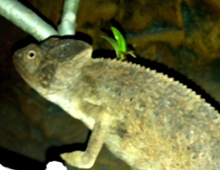Description: The Oustalet’s chameleon has a large body and long tail that ranges in colors from brown to green to blue. They have a large ridge from the end of their snout to the eyes, a smaller ridge from the eye to the back of the neck and a ridge of triangular spines from the back of the neck to the tail. The shield-like casque on top of the head can change color. There is a large plate on their head that points toward the back of the skull. Toes grow in groups, the back feet have three toes on the outside and two toes on the inside; front feet are opposite (zygodactyl toes).
Size: The male grows to a maximum length of 27 inches (68.5 cm); the females to 12 inches (30.5 cm). Weight is between 14-17 ounces (400-500 gr).
Behavior: The arboreal chameleon uses its long, prehensile tail and its feet for climbing. It is solitary and the male will sometimes turn blue during courtship rituals.
Diet: Diet consists of large insects, some fruits and occasionally small birds and reptiles. The long (about the same length as its body), muscular tongue has a sticky substance and a suction cup used to capture its prey.
Senses: Eyesight is very sharp. Their round, bulging eyes can move independently of each other, giving them 360-degree vision, with little body movement.
Communication: They change their color to communicate with other chameleons, to defend their territory, as mating displays and to camouflage themselves from predators.
Reproduction: After mating, the female lays up to 60 eggs after a gestation period of around 40 days.
Habitat/range: Oustalet’s chameleons are found in dry and moist habitats, at both high and low elevations throughout Madagascar.
Status: Listed as Least Concern on the IUCN Red List.



